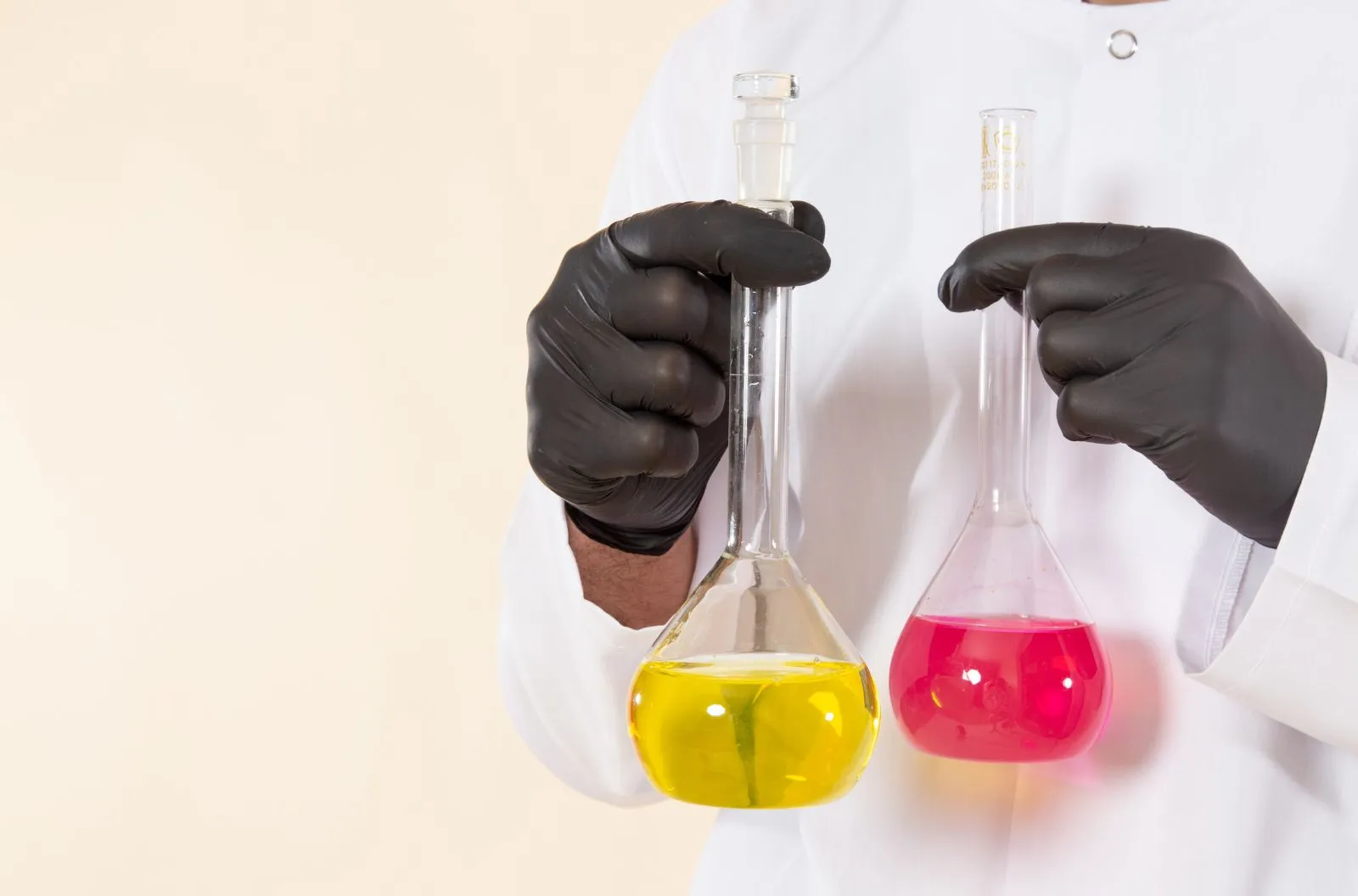TABLE OF CONTENTS
TABLE OF CONTENTS
When it comes to industrial and chemical applications, acids play a crucial role. Among the most commonly used are hydrofluoric acid (HF) and sulfuric acid (H₂SO₄). Both acids are powerful and have unique properties that make them indispensable in various fields. This article delves into the definitions, chemical compositions, properties, uses, and safety considerations of hydrofluoric acid and sulfuric acid, highlighting their key differences and applications.
Definition: Hydrofluoric Acid vs Sulfuric Acid
Hydrofluoric Acid (HF): Hydrofluoric acid is a solution of hydrogen fluoride (HF) in water. Unlike other strong acids, HF is a weak acid in its dilute form, meaning it does not fully dissociate in water. However, its chemical reactivity and ability to dissolve oxides and silicates make it extremely hazardous and useful in specific industrial processes.
Sulfuric Acid (H₂SO₄): Sulfuric acid is a highly corrosive, dense, oily liquid. It is a strong acid, meaning it fully dissociates in water. Sulfuric acid is one of the most widely used industrial chemicals, vital in the production of fertilizers, chemicals, and in petroleum refining.
Chemical Composition: Hydrofluoric Acid vs Sulfuric Acid
Hydrofluoric Acid (HF)
Formula: HF
Molecular Weight: 20.01 g/mol
Structure: Consists of a single hydrogen atom bonded to a fluorine atom. In aqueous solutions, it partially dissociates to form H⁺ and F⁻ ions.
Sulfuric Acid (H₂SO₄)
Formula: H₂SO₄
Molecular Weight: 98.08 g/mol
Structure: Comprises two hydrogen atoms, one sulfur atom, and four oxygen atoms. It dissociates in water to form H⁺ and HSO₄⁻ ions, with HSO₄⁻ further dissociating to H⁺ and SO₄²⁻ ions.
Physical Properties: Hydrofluoric Acid vs Sulfuric Acid
Hydrofluoric Acid
Appearance: Hydrofluoric acid is a colorless liquid or gas, depending on the concentration and temperature. In dilute solutions, it appears as a clear liquid, whereas concentrated solutions release pungent fumes.
Boiling Point: HF has a relatively low boiling point of 19.5°C (67.1°F), making it volatile at room temperature. This low boiling point necessitates careful storage and handling to prevent inhalation exposure.
Density: The density of hydrofluoric acid is approximately 0.98 g/cm³, which is close to that of water. This similar density can make it challenging to differentiate from water without proper labeling.
Solubility: HF is highly soluble in water, forming hydrogen bonds with water molecules. This solubility facilitates its use in aqueous solutions for various industrial processes.
Sulfuric Acid (H₂SO₄)
Appearance: Sulfuric acid is a colorless to slightly yellow, oily liquid. Its viscosity and oily nature increase with concentration, making concentrated sulfuric acid thicker and more viscous than dilute solutions.
Boiling Point: H₂SO₄ has a high boiling point of 337°C (639°F), indicating its stability at elevated temperatures. This high boiling point makes it suitable for high-temperature industrial processes.
Density: The density of concentrated sulfuric acid is about 1.84 g/cm³, significantly higher than water. This high density helps in distinguishing sulfuric acid from other liquids.
Hygroscopic Nature: Sulfuric acid is highly hygroscopic, meaning it readily absorbs moisture from the air. This property makes it useful as a drying agent in various applications.
Chemical Properties: Hydrofluoric Acid vs Sulfuric Acid
Hydrofluoric Acid (HF)
Acid Strength: Unlike many other strong acids, HF is a weak acid in dilute aqueous solutions, with a pKa of 3.17. It does not fully dissociate in water, resulting in only partial ionization to H⁺ and F⁻ ions.
Reactivity with Silicates and Glass: One of the most notable properties of HF is its ability to react with silicon dioxide (SiO₂) and silicate compounds. This reaction is utilized in etching glass and cleaning silicon wafers in the semiconductor industry.
Hydrogen Bonding: HF forms strong hydrogen bonds, contributing to its unique properties compared to other hydrogen halides. These hydrogen bonds also affect its boiling point and solubility characteristics.
Corrosiveness: HF is extremely corrosive, particularly to materials containing silica, such as glass. It can also corrode metals, ceramics, and organic tissues, necessitating strict handling and storage protocols.
Sulfuric Acid (H₂SO₄)
Acid Strength: Sulfuric acid is a strong acid, fully dissociating in water to release H⁺ ions. It has two dissociation steps, forming HSO₄⁻ and then SO₄²⁻ ions, making it a diprotic acid with strong acidic properties.
Dehydrating Agent: One of the most critical properties of sulfuric acid is its strong dehydrating nature. It can remove water from organic materials, leading to charring and carbonization. This property is utilized in various chemical reactions and industrial processes.
Oxidizing Agent: Concentrated sulfuric acid acts as a powerful oxidizing agent. It can oxidize metals, non-metals, and organic compounds, making it useful in synthesis and purification processes.
Corrosiveness: Sulfuric acid is highly corrosive to metals, organic tissues, and many other materials. It can cause severe chemical burns and must be handled with extreme caution, using appropriate personal protective equipment (PPE).
Key Differences in Properties
Acid Strength and Dissociation: Hydrofluoric acid is a weak acid that does not fully dissociate in water, whereas sulfuric acid is a strong acid that fully dissociates, releasing more hydrogen ions.
Boiling Points: HF has a low boiling point of 19.5°C, making it more volatile and hazardous to handle. In contrast, H₂SO₄ has a high boiling point of 337°C, making it more stable at higher temperatures.
Reactivity: HF is uniquely reactive with silicates and glass, a property leveraged in glass etching and semiconductor cleaning. H₂SO₄, on the other hand, is known for its strong dehydrating and oxidizing properties, used in various chemical manufacturing processes.
Physical State and Density: HF is less dense and can exist as a gas or liquid, while H₂SO₄ is a dense, oily liquid with a significantly higher density.
Corrosiveness: Both acids are highly corrosive, but HF’s ability to penetrate tissues and react with bone makes it particularly hazardous. Sulfuric acid’s corrosiveness and dehydrating ability also make it extremely dangerous.
Uses: Hydrofluoric Acid vs Sulfuric Acid
Hydrofluoric Acid (HF)
Glass Etching: Used in the manufacturing of glass products and semiconductors.
Metal Cleaning: Removes oxides and impurities from metals.
Petroleum Industry: Acts as a catalyst in the alkylation process for producing high-octane gasoline.
Chemical Synthesis: Essential for producing organofluorine compounds and fluorinated pharmaceuticals.
Sulfuric Acid (H₂SO₄)
Fertilizer Production
Phosphoric Acid Production: Sulfuric acid is crucial in producing phosphoric acid, which is then used to manufacture phosphate fertilizers. This process involves reacting sulfuric acid with phosphate rock to release phosphoric acid and calcium sulfate (gypsum).
Ammonium Sulfate: Another important use is in producing ammonium sulfate, a nitrogen-based fertilizer that provides essential nutrients to crops.
Chemical Manufacturing
Synthesis of Chemicals: Sulfuric acid is integral to producing various chemicals, including hydrochloric acid, nitric acid, sulfate salts, synthetic detergents, and dyes. Its strong acidic and dehydrating properties facilitate numerous chemical reactions.
Sulfonation Reactions: It is used in sulfonation reactions to introduce sulfonic acid groups into organic molecules, producing surfactants, dyes, and pharmaceuticals.
Petroleum Refining
Catalytic Cracking: In petroleum refining, sulfuric acid is used as a catalyst in the catalytic cracking process. This process breaks down large hydrocarbon molecules into smaller, more valuable fractions like gasoline and diesel.
Alkylation Process: Similar to HF, sulfuric acid is used in the alkylation process to produce high-octane gasoline. However, the specific processes and conditions differ between the two acids.
Industrial Cleaning and Metal Processing
Pickling of Steel: Sulfuric acid is widely used in the pickling of steel to remove rust, scale, and other impurities from the surface. This treatment is essential for preparing steel for further processing, coating, or galvanizing.
Descaling and Cleaning: It is also used to descale and clean various metal surfaces, enhancing the quality and longevity of the finished products.
Electrolyte in Batteries
Lead-Acid Batteries: Sulfuric acid is a critical component in lead-acid batteries, serving as the electrolyte. These batteries are commonly used in automotive and industrial applications due to their reliability and cost-effectiveness.
Wastewater Treatment
pH Adjustment: Sulfuric acid is used in wastewater treatment to adjust the pH of effluents. Proper pH control is necessary to neutralize alkaline wastes and ensure the safe discharge of treated water.
Dehydrating Agent
Concentrated Sulfuric Acid: Due to its strong dehydrating properties, concentrated sulfuric acid is used as a drying agent in various industrial processes. It can remove water from gases, organic compounds, and other materials, facilitating chemical reactions and processes that require anhydrous conditions.
Key Differences in Uses
Specialization
HF: Highly specialized for glass etching, semiconductor cleaning, and producing organofluorine compounds.
H₂SO₄: Broad applications, including fertilizer production, chemical synthesis, petroleum refining, metal processing, and use as an industrial dehydrating agent.
Industry Focus
HF: Predominantly used in the electronics, glass, and petroleum industries.
H₂SO₄: Widely used across agriculture, manufacturing, energy, and environmental management sectors.
Role in Petroleum Industry
Both acids are used in alkylation processes to produce high-octane gasoline, but HF acts as a direct catalyst, while H₂SO₄ serves both catalytic and dehydrating roles, depending on the specific refining process.
Safety: Hydrofluoric Acid vs Sulfuric Acid
Hydrofluoric Acid (HF)
Hazards: Extremely toxic, can cause severe burns, deep tissue damage, and systemic toxicity by penetrating the skin. HF exposure requires immediate medical attention and specific first aid measures, such as calcium gluconate gel.
Handling: Requires protective clothing, gloves, and eye protection. Work with HF should be conducted in a fume hood with proper ventilation.
Sulfuric Acid (H₂SO₄)
Hazards: Highly corrosive, can cause severe burns on contact with skin or eyes. Inhalation of vapors can damage the respiratory tract. Reacts exothermically with water, posing additional risks.
Handling: Requires appropriate personal protective equipment (PPE), including acid-resistant gloves, goggles, and face shields. Spills should be neutralized and cleaned up immediately with caution.
Conclusion
Hydrofluoric acid and sulfuric acid are indispensable in various industrial applications due to their unique properties. While HF is essential for its ability to etch glass and clean metals, H₂SO₄ is crucial in manufacturing, agriculture, and energy production. Both acids pose significant safety risks, requiring careful handling and appropriate safety measures.
Contact Us
Questions or looking for a quote?




